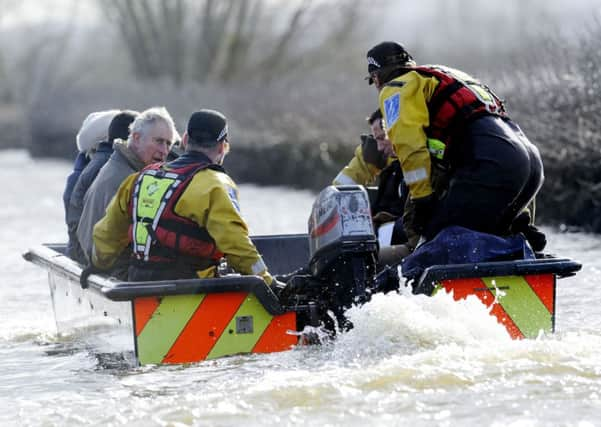Your plight is tragic, Charles tells flood victims


Flood alerts were in place last night covering the coast around Bridlington and land next to the Rivers Ouse and Derwent while nationwide three severe flood warnings, issued when there is “danger to life”, were in place in the South West, with 68 flood warnings across the country.
Ministers have faced growing criticism of their handling of the winter floods, particularly in Somerset where Prince Charles yesterday visited villages that have been underwater since Christmas.
Advertisement
Hide AdAdvertisement
Hide AdHe pledged a £50,000 donation to support flood victims, with the Duke of Westminster matching the funding with an additional £50,000.
Somerset residents have begged the Environment Agency to start dredging rivers, with many complaining they are living in “third world” conditions with “overflowing” septic tanks.
During a reception of 80 people in Stoke St Gregory, the Prince was recorded by ITV News saying: “There’s nothing like a jolly good disaster to get people to start doing something.
“The tragedy is that nothing happened for so long”.
Charles, who was wrapped up against the heavy winds, flooded roads and rain in a green weatherproof jacket and black wellington boots, attended a 45-minute-long reception, which was said to provide a “much needed” boost to the local community, before travelling onwards, by boat and tractor trailer, to Muchelney and Thorney which have been cut off for weeks.
Advertisement
Hide AdAdvertisement
Hide AdThe Somerset Levels suffered “once in 100 years” flooding in July 2012, but has endured even worse conditions from December. More than 128,000 acres have been deluged with around 40 homes under water and 200 more cut off.
Farmer Mike Curtis, with his wife Jenny and their two children, Rebecca, three and Tabitha, one, showed Charles their flood-damaged home and farm.
Speaking afterwards, Mr Curtis said: “He was a complete gentleman. The prince was very understanding and very sympathetic to our needs and was genuinely concerned and interested. His support will make a difference. He is very interested in farming and we talked about particular animal welfare issues that we face with the flood water.”
He also discussed with Charles the controversial issue of dredging the rivers on the Somerset Levels.
Advertisement
Hide AdAdvertisement
Hide Ad“He was understanding the point that the rivers have not been dredged for 20 something years and that if we don’t maintain it, it will deteriorate and will only get worse,” Mr Curtis added.
The Prince’s reception in Somerset was in stark contrast to that of Environment Secretary Owen Paterson, who drew criticism for arriving at Northmoor last week in a pair of smart city shoes.
The Country Land and Business Association (CLA) yesterday added its voice to calls for a review of the way flooding is handled after comments by Environment Agency chairman Lord Smith suggesting choices had to be made between defending towns and the countryside.
CLA North regional director Dorothy Fairburn said: “The Government says it values food security but we are never going to maintain it if prime areas of agricultural land are at risk of flooding. In the current economic climate there is clearly a need to cut public expenditure but Defra and the Environment Agency must review their priorities if we are to maintain and improve our ability to feed ourselves.”
Advertisement
Hide AdAdvertisement
Hide AdThe organisation said the Government should do more to cut red tape so that landowners can tackle flooding themselves.
She added: “In some cases individual landowners are willing to take on the responsibility for defences but they become frustrated by the huge amount of red tape and cost involved. IDBs (Internal Drainage Boards) work because they are run by stakeholders from the local community with a direct interest in preventing flooding. They are a perfect example of local decision-making that works and we need more of them.”
Comment: Page 12.